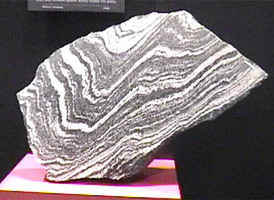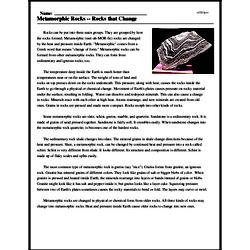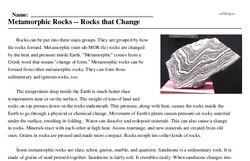Metamorphic Rocks -- Rocks that Change
Rocks can be put into three main groups. They are grouped by how the rocks formed. Metamorphic (met-uh-MOR-fic) rocks are changed by the heat and pressure inside Earth. "Metamorphic" comes from a Greek word that means "change of form." Metamorphic rocks can be formed from other metamorphic rocks. They can form from sedimentary and igneous rocks, too.
The temperature deep inside the Earth is much hotter than temperatures near or on the surface. The weight of tons of land and rocks on top presses down on the rocks underneath. This pressure, along with heat, causes the rocks inside the Earth to go through a physical or chemical change. Movement of Earth's plates causes pressure on rocky material under the surface, resulting in folding. Water can dissolve and redeposit minerals. This can also cause a change in rocks. Minerals react with each other at high heat. Atoms rearrange, and new minerals are created from old ones. Grains in rocks are pressed and made more compact. Rocks morph into other kinds of rocks.
Some metamorphic rocks are slate, schist, gneiss, marble, and quartzite. Sandstone is a sedimentary rock. It is made of grains of sand pressed together. Sandstone is fairly soft. It crumbles easily. When sandstone changes into the metamorphic rock quartzite, is becomes one of the hardest rocks.




